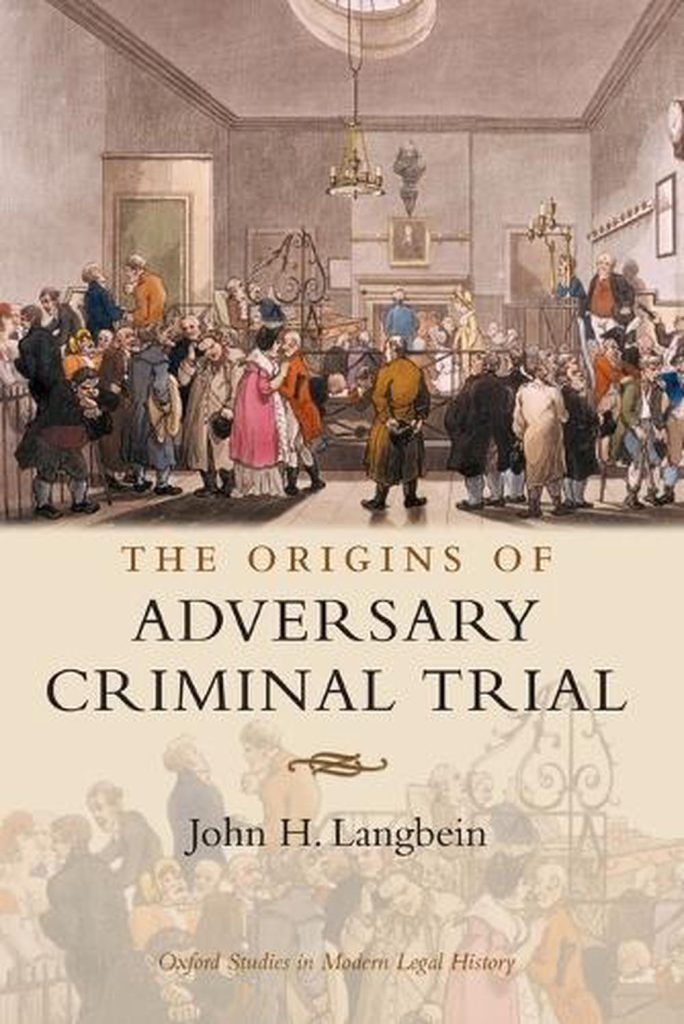Author: John H Langbein
Publisher: Oxford University Press
Reviewer: Stephen Keim
A friend of mine at the bar who has, like me, represented quite a few applicants for admission as legal practitioners who had one thing or another to disclose, very kindly, presented me with The Origins of Adversary Criminal Trial (“Adversary Trial”) to mark our joint adventures in a couple of more difficult than usual examples of this genre.
Adversary Trial was published in 2003 as part of the Oxford Studies in Modern Legal History series described as aiming to publish monographs of high quality and originality on legal history covering the period from 1750 onwards.
The General Editor of the series, the late AW Brian Simpson, points out the paradox that the substantive criminal law varies very little between common law and civil law systems while the procedure by which allegations of criminal offences are determined are very different. The contrast between the adversary criminal trial of common law jurisdictions where barristers compete to present to a jury of lay people competing versions of a narrative that flows from the evidence and the inquisitorial judicial investigation of the civil system could not be more different.
Adversary Trial seeks to explain the historical origins of these differences and demonstrate the reasons why the criminal trial in England developed in the way that it did. As Simpson points out, the understanding of this history was seriously in error because historians had drawn their understanding from the well-documented State Trials in which often high born people were prosecuted for treason. It was not understood that such trials were atypical of the multitude of criminal trials which were being conducted at the time at the Old Bailey and at assize courts around the nation.
Langbein’s magic ingredient for re-writing the development of the adversary criminal trial as we know it is a set of sources known as the Old Bailey Sessions Papers (“the Papers”). Langbein describes them as contemporaneously published pamphlet accounts of the trials at the Old Bailey. The Papers commenced as a trickle in the 1670s and were continuously published for almost two and a half centuries until the eve of World War I.
Langbein’s first experience of the Papers was a chance encounter in the Bodleian Law Library in the (northern hemisphere) Spring of 1977. One can infer that Adversary Trial is the culmination of 25 years of continuous scholarship using this new source of information and related primary and secondary sources.
Langbein describes the defining feature of criminal justice in England and other common law countries as not the availability of lawyers for defence and prosecution but the placement of responsibility for gathering and presenting evidence solely upon these parties. This is contrasted with European systems where the court and associated public officials have these responsibilities with the object of finding the truth as to what occurred. In contrast, the common law jury gets to choose between two contrasting views of reality presented, respectively, by the parties.
To take a hyper-modern view, the adversary trials with which the current generation of lawyers is familiar are not quite as oblivious to the truth as Langbein’s generalised view. The duties imposed on prosecutors to act in the public interest carries obligations which prevent a jury being presented with a wholly jaundiced view of reality by the prosecution. The requirement that the prosecution make disclosure of all relevant material held by it is also important. It ensures that the adversary trial is conducted in circumstances where the defence is aware of all of the strengths and weaknesses of the prosecution case well before the trial and can conduct the trial with all the tactical and strategic advantages that such information brings.
This qualification takes nothing from the contrast that Langbein draws. In some respects, it highlights aspects of the history in which it is suggested that some procedural and doctrinal changes were the product of perceptions that the defence were unfairly disadvantaged by the system as it existed at various times.
The starting position of Langbein’s exposition is a criminal trial (which had existed for centuries) in which the accused person was denied trial counsel; where the prosecution was conducted primarily by citizen accusers; and where the strategy behind the trial process was to gain access to the truth by forcing the accused person to give evidence on the basis that the accused person was often the only person who truly knew what had happened.
This form of altercation trial was underpinned by what was called the Marian pre-trial procedure (called thus because it followed the Marian Committal Statute of 1555, in the reign of Queen Mary). In this procedure, the local Justice of the Peace took depositions from the complainant and their witnesses and, sometimes, from the accused person (but not from witnesses for the accused) and, having done so, committed the accused to prison until the trial and bound over the complainant and the witnesses to appear at the trial on pain of punishment.
The system resulted in very short trials where the (usually, unrepresented and private, prosecutor) had the advantage of proofs of evidence while the hapless accused emerged, unassisted, from their prison cell and were forced to defend themselves before the jury the best way they could.
It was the unfairness of this altercation trial that led, eventually, to changes that produced the modern adversary trial to which Langbein refers.
Particularly venomous prosecutions of treason, involving the use of perjured evidence, in the late 17th century led to reforms of treason trials through the Treason Trials Act of 1896. An important reform was to create a right to counsel for defendants in such prosecutions. Langbein identifies a number of causes of the decision of judges in ordinary criminal trials to commence granting similar rights to defendants in those trials. These included a developing practice of prosecutors receiving the assistance of lawyers; the development of a rewards system for those who brought evidence of property crimes giving rise to a profession of thief takers whose evidence was likely to be questionable having been influenced by their need to earn the reward; and a similarly worrying practice of doing deals with persons who claimed to be accomplices who avoided prosecution by given evidence against others.
By the 1730s, these factors sufficiently worried judges hearing the cases to convince them to permit defendants in ordinary cases similar rights to counsel as applied in treason cases. Thus, the true adversary trial was born.
The same forces, also, tended, in accord with the urgings of the newly enfranchised counsel, to drive the development of the law of evidence. A strict rule requiring the corroboration of the evidence of accomplices, for example, was also apt to address the issue of perjury by a co-offender placing the blame on anyone but themselves.
The privilege against self-incrimination and the standard of proof beyond reasonable doubt descending upon the prosecution are further examples of the substantive law of evidence developing in tandem with the appearance of defence counsel in trials.
Three other matters of interest emerge from Adversary Trial. Langbein notes that the passive role of the judge as arbiter above the fray is consistent with the judge’s position in the earlier altercation trial since it was the private prosecutor assisted by the depositions from the Marian pre-trial process who brought the prosecution and presented the evidence before a similarly passive judge. Langbein also points out the influence of the draconian nature of the justice system under “the Bloody Code” when very minor offences carried the sentence of death. For those who ran the system, including judges and juries, a state of too much blood was more than enough was reached. As well as supporting the development of the adversary trial and the supporting rules of evidence, the desire to avoid capital punishment led to juries reaching compromise verdicts such as by finding the value of stolen goods to be below the amount which made the offence carry the penalty of death.
The third point of particular interest concerns Langbein’s analysis as to why the European system, with its emphasis on reaching the truth was not seen as an alternative to the judges who developed the adversary trial. Langbein’s answer is torture. Because judge ordered torture was an integral part of the European system, English judges were wary of any form of inquisitorial justice and creating the adversary trial was seen as a preferable way of instilling justice into a system which those at the heart, thereof, saw as unjustly tipped against the accused person.
Langbein’s workis a rare example of completely original legal history research being carried out in the dying decades of the twentieth century. The Papers constitute an extraordinary resource which lay unheeded in the archives of major research libraries for well over fifty years.
And Adversary Trial is a fascinating piece of writing which provides valuable context to the system in which we work as twenty-first century lawyers. It certainly merits its inclusion in the Oxford Studies in Modern Legal History series.
Now to work out a way to incorporate it into my next set of submissions at the Caboolture Magistrates Court.



